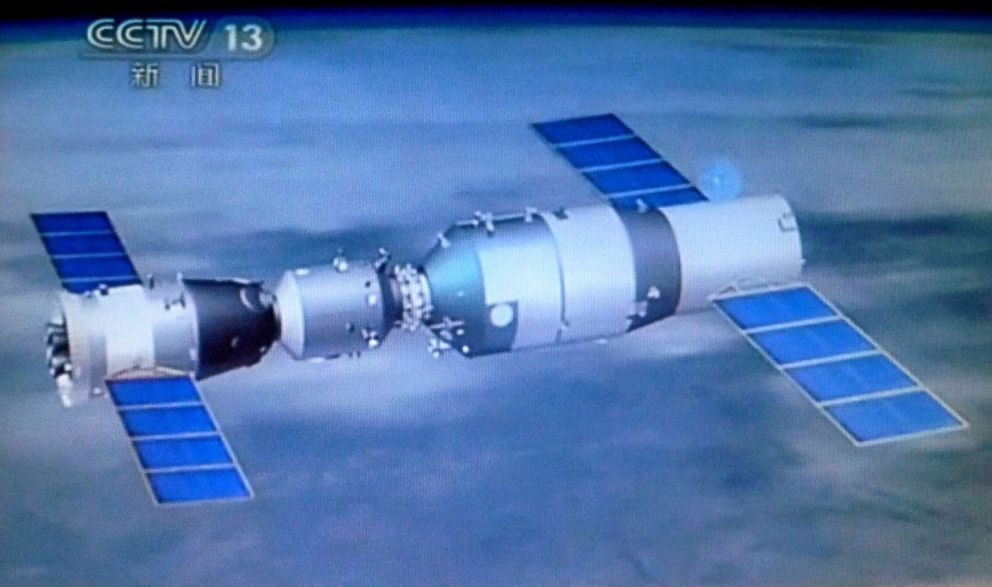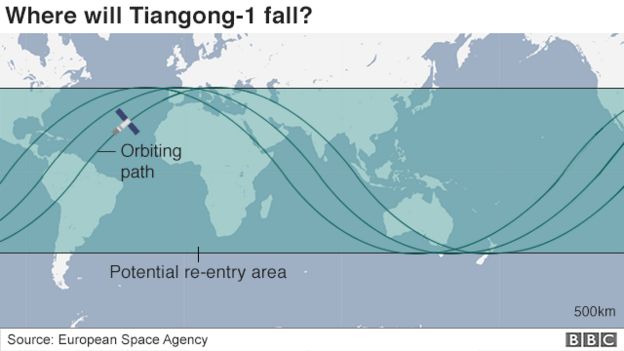Navigation
Install the app
How to install the app on iOS
Follow along with the video below to see how to install our site as a web app on your home screen.
Note: This feature may not be available in some browsers.
More options
You are using an out of date browser. It may not display this or other websites correctly.
You should upgrade or use an alternative browser.
You should upgrade or use an alternative browser.
Track a de-orbiting Chinese space station
- Thread starter mhansen2
- Start date
waltky
Wise ol' monkey
Granny says, "Dat's right - the sky is fallin'...

Chinese space station set to plummet uncontrolled back to Earth
Mar 25, 2018, What goes up, must come down

Chinese space station set to plummet uncontrolled back to Earth
Mar 25, 2018, What goes up, must come down
Simply put, that's why there's so much interest in Tiangong-1, China's first space station, which was launched in 2011 and has been in decreasing orbit ever since. China admitted last year it no longer had control of the space station –– and now it’s getting close to plummeting back to Earth. Most of it will burn up on re-entry, but there’s always a chance some of it will survive and hit Earth. That said, most of our planet is covered by water so the odds are overwhelming it will splash down in an ocean someplace.

China is already building another more ambitious space station -- Tiangong-2 was launched in 2016 -- as well as a lunar base, and is ramping up its space program dramatically. The European Space Agency is now sending its astronauts to train in China, since there is so little opportunity with NASA these days. NASA shut down its Space Shuttle Program following the launch of Atlantis in July 2011 and has sent astronauts up to the International Space Station on Russian launches ever since. The last manned mission to Tiangong-1 was in 2013.
When will it crash back to Earth?
Much depends on angle, velocity and atmospheric density –- but current predictions have it re-entering as early as March 29 and as late as April 2.
What are the odds someone will get hit?
Aerospace Corporation, which tracks space junk for NASA and Space Command, says the odds you will be hit -- even if you are in the highest-probability zones -- are about 1 million times smaller than the odds of winning the Powerball jackpot. The only known person to have been hit by space junk is Lottie Williams of Tulsa, Oklahoma. She was hit, and uninjured, when a used Delta II rocket burned up on re-entry in January 1997.
Who has the highest risk?
waltky
Wise ol' monkey
Granny says she gonna sue dem Chinamens...

What to do if this Chinese space station crashes into your house this weekend
Mar 30, 2018 - A Chinese space station is tumbling uncontrollably toward Earth, and no one will know where its pieces will land until hours before it gets here.

What to do if this Chinese space station crashes into your house this weekend
Mar 30, 2018 - A Chinese space station is tumbling uncontrollably toward Earth, and no one will know where its pieces will land until hours before it gets here.
Though its name means “heavenly palace,” the space station, named Tiangong-1, lasted only five years before malfunctioning. It launched in 2011 with a two-year mission. The last astronauts departed the 10-ton station in June 2013, and Chinese officials put the space station into sleep mode, expecting it would remain operational until they could facilitate a controlled re-entry. But in March 2016, Tiangong-1 unexpectedly stopped working, according to a letter filed to the United Nations. Since then, the school bus-sized station has tumbled through space, gradually slowing and falling out of orbit due to atmospheric drag. Though our atmosphere becomes thinner as you increase altitude, its upper limit is 6,200 miles above sea level. In low-Earth orbit, the air is still thick enough to create drag and bring down the wayward station.

This map show locations where space debris from Tiangong-1 could collide, namely anywhere between latitudes 42.8 North and 42.8 South.
While your chances of being hit by a piece of Tiangong-1 are tiny — 10 million times less than your chances of being hit by lightning this year — the risk will be impossible to calculate until its final descent begins. And the risk encompasses more than just being struck by space, due to the hazardous materials potentially inside the space station. If the Tiangong-1 spreads these materials over thousands of miles, the risk of injury is still high. s of March 30, scientists predict Tiangong-1 will make its final plunge on April Fool’s Day, but there is a 14-hour window of uncertainty. (You can track the descent here and here). “Only in the hours directly before the real re-entry can we narrow this window down to tens of minutes,” Dutch satellite tracker Marco Langbroek told the PBS NewsHour.

The lines on this map show where Tiangong-1 could come down. Cities with populations larger than 1 million people between the target latitudes are marked in red.
While much of the space station will break apart and burn during re-entry, scientists at the European Space Agency expect between 20 to 40 percent — 1.5 to 4 tons — of Tiangong-1 to survive the fiery plummet because the space station is so big. And pieces of rocket engines possess a higher likelihood of survival. Based on Langbroek’s calculations and those made by the European Space Agency, Tiangong-1’s surviving parts are most likely to land in the ocean, but they could also hit anywhere across “the whole of Africa, Australia, New Zealand and the southern parts of Europe and Asia, South America and United States,” Langbroek said. So, in the event that a remnant of Tiangong-1 lands in your backyard or destroys your car, here’s a guide to what you should do.
Step 1: Don’t touch anything
“You shouldn’t go run over and smell it, and you probably shouldn’t go pick it up,” said Laura Grego, a physicist and global security expert with the Union of Concerned Scientists. It’s unclear what hazardous materials might have been inside Tiangong-1, she said. One example is hydrazine, a highly toxic and corrosive substance used as spacecraft fuel. “There are pressure spheres and fuel tanks on these kinds of space stations. Those especially have a tendency to survive,” Langbroek said. Still, only one person in history — Lottie Williams of Tulsa, Oklahoma — has been hit on the ground by falling space debris.
Step 2: Call a diplomat
IsaacNewton
Gold Member
- Jun 20, 2015
- 17,308
- 3,697
- 290
It's supposed to crash on Easter Sunday.
So let it be written, so let it be done.
So let it be written, so let it be done.
waltky
Wise ol' monkey
Uncle Ferd got his tinfoil hardhat on...

Tiangong-1: China space lab's return approaches
1 Apr`18 - The estimated window of re-entry for the defunct Chinese space lab Tiangong-1 has narrowed sharply.
See also:
China's defunct space lab hurtling toward Earth for re-entry
Mar 29, 2018, China's defunct and reportedly out-of-control Tiangong 1 space station is expected to re-enter Earth's atmosphere sometime this weekend. It poses only a slight risk to people and property on the ground, since most of the bus-size, 8.5-ton vehicle is expected to burn up on re-entry, although space agencies don't know exactly when or where that will happen.

Tiangong-1: China space lab's return approaches
1 Apr`18 - The estimated window of re-entry for the defunct Chinese space lab Tiangong-1 has narrowed sharply.
The timeframe for the fall to Earth is centred on 01:07 Monday GMT (02:07 BST), plus or minus two hours. Experts are tracking the module as it orbits at an ever decreasing altitude. However, they will only be sure of the timing of the final plunge very late in the descent because of the uncertainties over Tiangong's interactions with the high atmosphere. China has lost communication with the module and there is no way to control its downward flight.
However, the risk of any parts of Tiangong hitting a populated area is considered very low. "Given Tiangong-1 has a larger mass and is more robust, as it is pressurised, than many other space objects that return uncontrolled to Earth from space, it is the subject of a number of radar tracking campaigns," explained Richard Crowther, the UK Space Agency's chief engineer. "The majority of the module can be expected to burn up during re-entry heating, with the greatest probability being that any surviving fragments will fall into the sea," he told BBC News.

* Precise knowledge of the re-entry time and location will come late
* Typically, only in the last hour or so are experts very confident
* Most of the module's components will burn up in the high atmosphere
* Its orbital path means any debris is restricted in where it can fall
* Perhaps 20-40% could survive to the surface - that's 1.5-3.5 tonnes
* The highest probability is that this material would hit the ocean
* Any debris path at the surface would be hundreds of km long
* Tiangong is the 50th most massive object to come back uncontrolled
Launched in 2011 and visited by six Chinese astronauts, the 10m-long, 8.5-tonne Tiangong module should really have been de-orbited in a planned manner. Traditionally, thrusters are fired on large vehicles to drive them towards a remote zone over the Southern Ocean. But this option appears not to be available, especially after the loss of command links in 2016. Tiangong is now brushing through the top of the atmosphere, which is dragging on the spacecraft and causing it to lose altitude rapidly. Thirteen space agencies, under the leadership of the European Space Agency, have been using radar and optical observations to follow its path around the globe, modelling its behaviour.

This collective, known as the Inter-Agency Space Debris Coordination Committee (IADC), has issued regular updates on the descent progress, and Esa itself gave its own final bulletin on Sunday. This forecast was for a four-hour re-entry window centred on 01:07 GMT Monday. "A confidence of one hour is only reached about four hours beforehand. And one hour still means almost one revolution around the Earth," said Holger Krag, the head of Esa's space debris office. "But that's still good enough to exclude many countries and even some continents."
MORE
See also:
China's defunct space lab hurtling toward Earth for re-entry
Mar 29, 2018, China's defunct and reportedly out-of-control Tiangong 1 space station is expected to re-enter Earth's atmosphere sometime this weekend. It poses only a slight risk to people and property on the ground, since most of the bus-size, 8.5-ton vehicle is expected to burn up on re-entry, although space agencies don't know exactly when or where that will happen.
Below are some questions and answers about the station, its re-entry and the past and future of China's ambitious space program.
WHAT WILL HAPPEN AND HOW GREAT IS THE DANGER?
The European Space Agency predicts the station will re-enter the atmosphere between Saturday morning and Sunday afternoon — an estimate it calls "highly variable," likely because the ever-changing shape of the upper atmosphere affects the speed of objects falling into it. The Chinese space agency's latest estimate puts re-entry between Saturday and Wednesday.
Western space experts say they believe China has lost control of the station. China's chief space laboratory designer Zhu Zongpeng has denied Tiangong was out of control, but hasn't provided specifics on what, if anything, China is doing to guide the craft's re-entry. Based on Tiangong 1's orbit, it will come to Earth somewhere between latitudes of 43 degrees north and 43 degrees south, or roughly somewhere over most of the United States, China, Africa, southern Europe, Australia and South America. Out of range are Russia, Canada and northern Europe.
Based on its size, only about 10 percent of the spacecraft will likely survive being burned up on re-entry, mainly its heavier components such as its engines. The chances of anyone person on Earth being hit by debris is considered less than one in a trillion. Ren Guoqiang, China's defense ministry spokesman, told reporters Thursday that Beijing has been briefing the United Nations and the international community about Tiangong 1's re-entry through multiple channels.
HOW COMMON IS MAN-MADE SPACE DEBRIS?
TheOldSchool
Diamond Member
- Banned
- #7
If it crashes into and destroys the temple mount, then I’ll finally become a believerIt's supposed to crash on Easter Sunday.
So let it be written, so let it be done.

mhansen2
Gold Member
- Thread starter
- #8
It splashed into the Southern Pacific
Farewell, Tiangong-1: Chinese Space Station Meets Fiery Doom Over South Pacific
Farewell, Tiangong-1: Chinese Space Station Meets Fiery Doom Over South Pacific
waltky
Wise ol' monkey
Granny says, "Dat's right - much ado `bout nuthin' - it crashed inna ocean...

Chinese Space Lab Burns Up in the Atmosphere
April 01, 2018 - A defunct Chinese space lab met its expected end early Monday morning as its remaining fragments plunged into the South Pacific.

Chinese Space Lab Burns Up in the Atmosphere
April 01, 2018 - A defunct Chinese space lab met its expected end early Monday morning as its remaining fragments plunged into the South Pacific.
China's Manned Space Engineering Office said the Tiangong-1 spacecraft “mostly” burned up in the atmosphere. Any pieces that failed to disintegrate during the fiery trip back to Earth fell harmlessly into the ocean. It took about two hours for the craft burn up once it hit Earth's atmosphere. There had been predictions parts of the space lab would land in the South Atlantic with some pieces posing a very small threat to people on the ground.

A view of the Space Debris Room of the European Space Agency ESA in Darmstadt, Germany,
Tiangong-1, was the size of a school bus and weighed eight and a half tons. Tiangong-1, which means “Heavenly Palace” in English, was the largest manmade object to re-enter Earth’s atmosphere in a decade. It was launched in 2011 and served as an orbiting laboratory for manned Chinese space missions until officials determined its lifespan was complete. It was taken out of service in 2016.
Chinese Space Lab Burns Up in the Atmosphere
harmonica
Diamond Member
- Sep 1, 2017
- 43,841
- 20,021
- 2,300
as many should've known--the earth is mostly waterIt splashed into the Southern Pacific
Farewell, Tiangong-1: Chinese Space Station Meets Fiery Doom Over South Pacific
Similar threads
- Replies
- 5
- Views
- 601
- Replies
- 16
- Views
- 959
- Replies
- 5
- Views
- 505
Latest Discussions
- Replies
- 160
- Views
- 902
- Replies
- 80
- Views
- 359
- Replies
- 94
- Views
- 413
Forum List
-
-
-
-
-
Political Satire 8872
-
-
-
-
-
-
-
-
-
-
-
-
-
-
-
-
-
-
-
ObamaCare 781
-
-
-
-
-
-
-
-
-
-
-
Member Usernotes 492
-
-
-
-
-
-
-
-
-
-